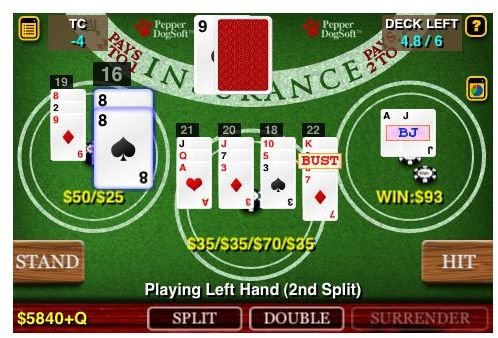

With naïve play, which ignores the dealer's up card, you would almost certainly hit a 12 or 13. This is your best defense against the house advantage. The dealer will have to hit, and might bust. You are tempted to hit, but you might bust, so you stand. This represents the situation where both you and the dealer have bad hands-your total and the dealer's expected total are each less than 17. In our functions, the subarray HARD(12:16,2:6) is nearly all zero. The most important consideration in basic strategy is to avoid going bust when the dealer has a chance of going bust. The return value is 0, 1, or 2, indicating "stand," "hit," or "double down." The other two functions, soft and pair, play similar roles for hands containing an ace worth 11 and hands containing a pair. The row index into HARD is the current total score, and the column index is the value of the dealer's up card. The function hard uses the array HARD to guide the play of most hands. My MATLAB programs, shown in the sidebar, use three functions to implement basic strategy. With basic strategy, the house advantage is only about one half of one percent of the original bet. Your play depends only on your current hand and the dealer's up card. The strategy assumes that you do not retain information from earlier hands. It is now presented, with a few variations, on dozens of web pages, including Wikipedia. On your first two cards:īasic strategy was first described in the 1956 paper "The Optimum Strategy in Blackjack," published in the Journal of the American Statistical Association by four authors from the Aberdeen Proving Ground. The fact that you can bust before the dealer takes any cards is a disadvantage that would be overwhelming were it not for three additional features of the game. Equal totals are a "push," and neither wins. (A variant has the dealer draw to a "soft" 17, which is a hand with an ace counting 11.) If neither player goes bust, then the hand closest to 21 wins. The dealer has no choices to make, and must draw on hands worth less than 17 and stand on hands worth 17 or more. If your total ever exceeds 21, you are "bust," and the dealer wins the hand without drawing any more cards. When you are satisfied with your hand, you "stand." The dealer then reveals the hidden card and finishes the hand. You signal "hit" to receive additional cards. Your cards are dealt face up one of the dealer's cards stays face down. Face cards are worth 10 points, aces are worth either 1 or 11, and all other cards are worth their numerical value.

Simulating blackjack play with this strategy in MATLAB ® is both an instructive programming exercise and a useful parallel computing benchmark.īlackjack is also known as "21." The object is to get a hand with a value close to, but not more than, 21. Using a basic strategy, a knowledgeable player can reduce the casino's advantage to less than one-half of one percent.

Blackjack is the most popular casino game in the world.


 0 kommentar(er)
0 kommentar(er)
